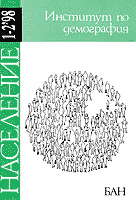КОНЦЕПЦИЯ ПОВОЗРАСТОВОЙ СМЕРТНОСТИ КАК МЕТОДИЧЕСКИЙ И МЕТОДОЛОГИЧЕСКИЙ ЦЕНТР СТАТИСТИЧЕСКОГО ИЗУЧЕНИЯ СМЕРТНОСТИ
The Concept of Age-specific Mortality as a Methodological Come For the Statistical Analysis of Mortality
Author(s): Nikola TcholakovSubject(s): Social Sciences
Published by: Институт за изследване на населението и човека - Българска академия на науките
Keywords: Age-specific Mortality;
Summary/Abstract: In this paper we discuss the potentiality and advantages of the age-specific mortality rate for infinitely small age intervals when this rate simultaneously converges to what is well known in Demography as the Force of Mortality. This indicator is popular in natural science as Infinitesimal Rate of Change, a terminology which is often related to Isaac Newton works in Physics. In Demography we could think of it as the impetus, the impulse, the instant risk of mortality entirely specific for any single age. Therefore the force of mortality seems to be the most precise mortality rate, which is independent of the age intervals and the way mortality data are grouped. This may lead to the feeling that this indicator is too much abstract, has only theoretical value and is difficult to apply in the statistical practice. It has of course a significant conceptual value, as we are trying to demonstrate here. With the force of mortality one could easily explain almost all interdependences between the remaining mortality indicators, including those of the life table. But it is not that difficult to implement this indicator in practice, as we hope to show it here. Actually, for this purpose we only need standard age-specific mortality data and some reasonable approximations and common numeric methods to calculate the force of mortality for any single age.
Journal: Население
- Issue Year: 1998
- Issue No: 1+2
- Page Range: 17-29
- Page Count: 13
- Language: Bulgarian
- Content File-PDF

